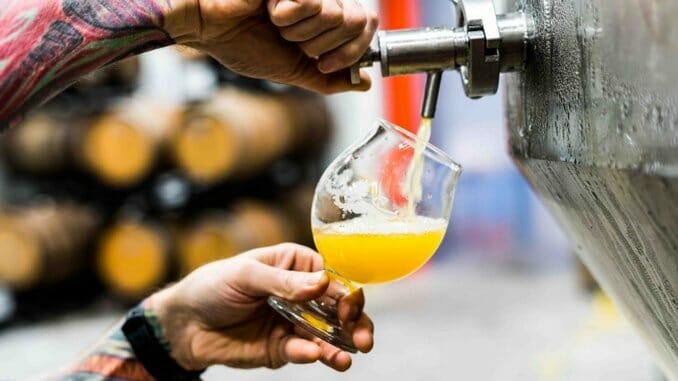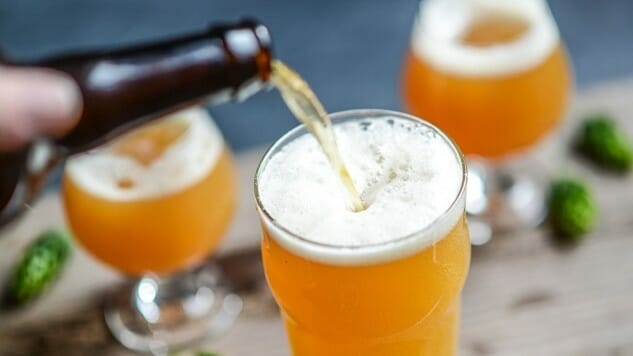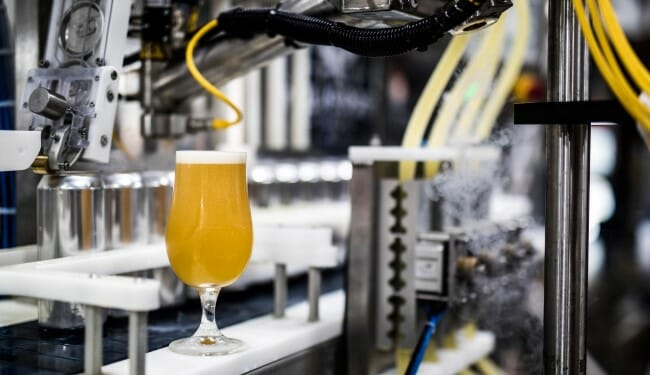How One Beer Geek Fell out of Love With Hazy IPA
Photo via Unsplash, Evan Dvorkin, Brewers Association
Sitting here in 2020, in the midst of a still-unfolding pandemic, multiple summers into the era of hard seltzer, it feels like it’s been considerably more than two years since we conducted a ridiculously large blind tasting of 324 IPAs at Paste.
If you had asked me to cite some of my favorite beer styles in advance of that particular blind tasting, I don’t think there’s a shred of doubt that one of my first responses would have been modern, hazy IPA, or “NE-IPA” as we were more commonly calling it at the time. I had fallen in love with the style as much as anyone in the mid-2010s, watching the influence of pioneers like The Alchemist’s Heady Topper radiate across the country, gaining footholds on the East Coast first, before gradually being adopted everywhere. It was hard not to be charmed by the style’s easygoing disposition, fruit-forward flavors, lack of bitterness and continued evolution of the “juicy” flavor profile that had already been sought after in clear India pale ales of the period. It seemed like a clear reflection of changing consumer tastes, and I was excited to try new hazy IPAs from nearly every brewery I visited.
In the course of that blind tasting of 324 IPAs, however, a certain dissatisfaction with the style began to grow within me for the first time. Beers that I found refreshing and charming a few years earlier now seemed increasingly rote and uninspired, as it became clear that so many were chasing after a very similar, narrowly defined ideal. Worse still, we began to notice that many breweries were taking the concept too far, overloading their hazy IPAs with unpalatable levels of hop flavor, which ultimately tended to have the opposite effect that was intended. IPAs created with maximum “juice” in mind were instead tasting like sludgy plant matter in a 16 oz wrapped can, and beer drinkers were still raving about how great they were regardless, seemingly unable to tell the difference. It was disconcerting, to say the least.
In the last two years, I’ve swung up and down at times on hazy IPA. What complicates the matter is the fact that, in the right hands, they’re capable of being transcendentally delicious beers. In the last few weeks, in fact, I’ve had examples from Braddock, PA’s The Brew Gentlemen (General Braddock’s IPA) and Richmond’s Triple Crossing (DDH Falcon Smash) that are nothing short of perfection—symphonies of luxuriant orange, peach and tropical juiciness, backed by dank elements and whispers of accompanying bitterness, without letting the residual sweetness get completely out of hand. But those types of beers, which I once would have thought of as the rule for the style, have instead become the exception to me. There’s just so much bad hazy IPA out there now that it feels more statistically likely you’ll get a bad one than a good one at this point. As a result, it’s much harder to be enthusiastic about sampling new ones.
Moreover, the industry’s obsession (and the beer geek’s obsession as well) with the style, motivated of course by economic necessity at an all-time high level of craft brewery competition, has made hazy IPA into such a staple that it now tends to suck all the rest of the energy out of the room. Visit seemingly any brewery founded in the last decade, and hazy IPA is everywhere, and their omnipresence in dominating draft lists has instilled a great desire in me for more variety. It’s reached the point where I feel so completely inundated with sweet, “juicy” hop profiles from all sides that I’ve almost invariably come to crave the opposite whenever presented with a choice. Whether it’s the dry roastiness of porter/stout or the crisp, alternative noble hoppiness present in a great pilsner or helles lager, these beers speak to me in a way that the style of hazy IPA no longer does. I’m officially burned out.
Wanting to put these feelings into words, I settled on three specific factors that have led to my disillusionment with hazy IPA. They are as follows.
1. The Saturation of “Same-y” Limited Releases
Picture a brewery known for their hazy IPAs, and a few things will almost always follow.
One: They have leaned into the style as much as possible, because it’s one of the few dependable drivers of the craft beer segment at a time when spirits and seltzer are chipping away at the edges and there are more brewery competitors than ever.
Two: They produce a lot of new hazy IPAs, on a schedule that rolls out new beers (and especially can releases) like clockwork. They might have a new hazy every single week. Hell, they might have multiple new hazy IPAs on a weekly basis. This has become the de facto expectation for so many of the breweries that focus on hazy IPA, and the countless breweries that imitate them.
 The hazy spice must flow.
The hazy spice must flow.
There may be a few flagships that don’t change at any given brewery, but the hazy IPA market is very much driven by the same quest for constant novelty that beer geeks were taught to appreciate during the industry’s boom period. For a few decades, breweries extolled the virtue of new and novel, fresh and local, and it ultimately built a culture of what we sometimes call “tickers”—drinkers committed to trying ANYTHING new, rather than something they’ve had before. This in turn incentivizes the breweries to constantly pump out new releases in an effort to reach these drinkers and maintain hype, and before you know it, you have a vast portfolio of hazy IPAs. Is it any wonder that quality is then likely to slip, given the mandate to constantly debut new, relatively untested recipes, rather than ones that have been tweaked and improved? Who’s going to be doing their best work while they’re under the gun? This is how subpar beer gets put out into the world, but because limited releases will invariably receive better Untappd ratings than year-rounders, it’s an integral part of maintaining the hype cycle. Our over-valuation of “new” has hurt this style badly.
Likewise, once you have a big menu full of hazy IPAs, it’s all the more likely that the consumer will begin to realize how similar so many of these beers end up being. There are several dimensions to the pursuit of juiciness, yes, but even those distinctions are increasingly lost as the hop rate on all these beers continues to climb. You’ll note that many of the breweries known for hazy IPA will talk a big game on their use of nouveau or experimental hop varietals as something that they’re hoping will give each individual IPA or DIPA more distinction, but this doesn’t work as well in practice as it does in theory—not least because these novel varieties are often being used in such ridiculous quantities that all that remains is overpowering “green” and vegetal notes. The result is a lot of supposedly exotic, “new” IPA that has a very hard time distinguishing itself from the exotic “new” IPA of last week, and the week before that. Everything simply blurs together.
Case in point: A while back, I visited a nationally hyped brewery known for hazy IPA. Their menu? It had 11 IPAs and DIPAs on it that day. That’s eleven. Double digits, all on tap at once. And it’s all the more sad for the fact that I know this brewery can do so many other styles well, from lager and English mild ale to mixed ferm wild ales or classic German hefeweizen. They’ve produced sparkling examples of all those beers at some point in the past, but when 80% of the menu is slight variations upon a single theme—most of them limited releases that may never be made again—how can you not lament the missed opportunity to diversify? Would it really hurt so much to have merely 6 or 7 hazy IPAs on at once, rather than 11? Who wants to taste their way through a lineup where almost every beer uses the same descriptive language?
And sadly, the industry is in such a place right now where even the universally beloved and respected stalwarts, breweries that made their name by brewing the furthest thing from hazy IPA, apparently feel like they have no choice but to jump on the train. Look no further than somewhere like Ommegang, a brewery we recently wrote about in honor of their deeply influential saison Hennepin. Even Ommegang, a brewery built almost entirely around traditional Belgian ales, has a full series of hazy IPAs now. The style is so pervasive that even breweries built around the opposite of IPA feel they have to participate.
2. Maximum Bombast
I have an issue with the descriptive language used for the vast majority of modern hazy IPAs—they always have to be the biggest, the boldest, the craziest, the juiciest. There’s seemingly no room in the style for merely “juicy.” Merely “juicy” IPA is so early 2010s. No, if you’re making a hazy IPA now, it has to aspire toward fruitiness and juiciness on a level that transcends actual fruit and crosses over into the realm of candy fruit flavorings. If these breweries could simply fill bottles with apricot nectar and Pixy Stix and call it beer, I can only imagine that they would.
This feeling that everything needs to be cranked up to 11 in order to get attention from the drinkers has multiple negative effects, starting with the fact that the higher the hop rates climb, the less juicy these beers tend to present. We’ve got an entire generation of young breweries right now acting as if there’s a direct correlation between “more hops” and “more juicy,” while totally ignoring that there is absolutely a point of diminishing returns that is quickly reached. Once you pass that point, each additional pound of pellets you’re dumping into your kettle is taking the final result further from “juicy,” and in the direction of “vegetal.” All that lovely varietal hop character is washed away by a profile that tastes predominantly of wet grass and plant matter.
 Finding a way to cram more hops into your IPA isn’t the solution—it’s the problem.
Finding a way to cram more hops into your IPA isn’t the solution—it’s the problem.
This kind of thinking is endemic to craft beer as a whole in 2020. It’s an era where seemingly every big stout must aspire toward absurd, desserty decadence and half a dozen adjuncts; where every fruited sour is basically pulpy puree with alcohol in it—and often not as much alcohol as is advertised. Tooth-stripping sweetness is the norm; something to be expected in all these styles as well, whether it’s stout, or a fruited sour, or hazy IPA. They’re the hallmarks of an era that has long since waved goodbye to any sense of proportion or dignity—the highest rated beers of our era have an uncomfortable tendency to sound like something a child would have designed if given the chance. If you let your 6-year-old nephew design a beer, would he not say “I want a chocolatey beer, with bananas, and blueberries, and maple syrup and vanilla!”
Subtlety still exists in the craft beer world, but it’s encamped on the fringes in 2020, watching as the styles currently serving as the genre’s spirit animals (hazy IPA, pastry stout, fruited sours) throw what amounts to a raucous kegger in what was formerly its house. And until beer drinkers rediscover an appreciation for flavors that are delicate or subtle, “punch you in the face with the most obvious flavors” will presumably remain the prevailing standard, which only encourages the worst types of one-upsmanship from the breweries.
3. The Sheer Difficulty of Drinking Modern Hazy IPA
On the most basic possible level, modern hazy IPA is increasingly defined by being hard to drink, especially in quantity. How this managed to become the norm, I have no idea, but drinkers have accepted that too-sweet, too-sticky, too-gritty, too-yeasty, too-vegetal, too-corrosive IPA is not only acceptable for the style, but the apex of the modern beer world. We’ve all been led so far astray that the guys living on Untappd are handing out five stars to beers that aren’t just hard to drink, but awarding those beers because they’re hard to drink, as if that’s a feature rather than a flaw.
The reference to “corrosive” textures is something I’ve talked about before, in what would have to be considered a precursor to this very essay. That concept is known as “hop burn” to some beer geeks, and describes the way the mouthfeel of these hazy IPAs loses the “full and creamy” texture that is desired, instead becoming harsh and acidic because of the sky-high levels of hop oils (or suspended yeast) left in the beer. As I described it previously:
It’s the sensation one gets while drinking poorly made NE-IPAs that your very throat has become coated in a corrosive, vegetal substance that leaves a long-lasting astringency on the palate. It’s become an all-too-common staple of even some of the country’s most sought-after hazy IPAs, as the drinkers of these beers seem increasingly unable to distinguish “juicy” from something that evokes the mouthfeel of bile or stomach acid.
 It’s not like we’re the only ones who have noticed this phenomenon.
It’s not like we’re the only ones who have noticed this phenomenon.
Put simply, the best beers in this segment don’t have the hop burn—they finish cleanly, with perhaps a kiss of residual sugar, but they’re also dry enough to quickly promote that next sip. Hell, maybe they even have a little bit of (shudder) hop bitterness for balance! Increasingly, though, these beers leave your throat feeling like it’s been rubbed raw with sandpaper. At a certain level of hop saturation, it just seems to become unavoidable. Combined with the cloyingly sweet levels of residual sugar in so many of these beers, it’s a one-two punch that makes it hard to get through one glass of many hazy IPAs, let alone a second.
All of these things—along with being told by professional brewers that I should “wait a few weeks” before sampling their new batch of IPA, because it’s still too green and corrosive-tasting—have contributed to my diminished appreciation for the style. India pale ale was headed in a positive direction in the first half of the 2010s, broadening its appeal and variety of flavors after the IBU arms race of the late 2000s. But we took our newfound lust for juice, sweetness and decadence too far, eventually losing the very thing we were seeking. Today, that leaves IPA in bizarre, uncharted territory, pushing itself further and further in a direction that is inherently unpalatable.
What can we do about it? Well, as I wrote last year, a renewed appreciation for subtlety is perhaps the only thing a consumer can do at this point. We need to restart from the ground up, experiencing beers with descriptions that aren’t littered with bombastic adjectives and exclamation points. We need to proclaim an appreciation for those more humble, more balanced styles. Perhaps then, breweries will begin to acknowledge that not every hazy IPA needs to be made with the intention of being the be-all, end-all of the concept of “juiciness.” Perhaps then we’ll be able to admit that toning down the hop presence of some of these beers might actually help the “juice” come through more cleanly.
It’s a fantasy, I’m sure. But one day, I’d really like to count hazy IPA among my favorite beer styles once again.
Jim Vorel is a Paste staff writer and resident craft beer geek. You can follow him on Twitter for much more drinks writing.







































